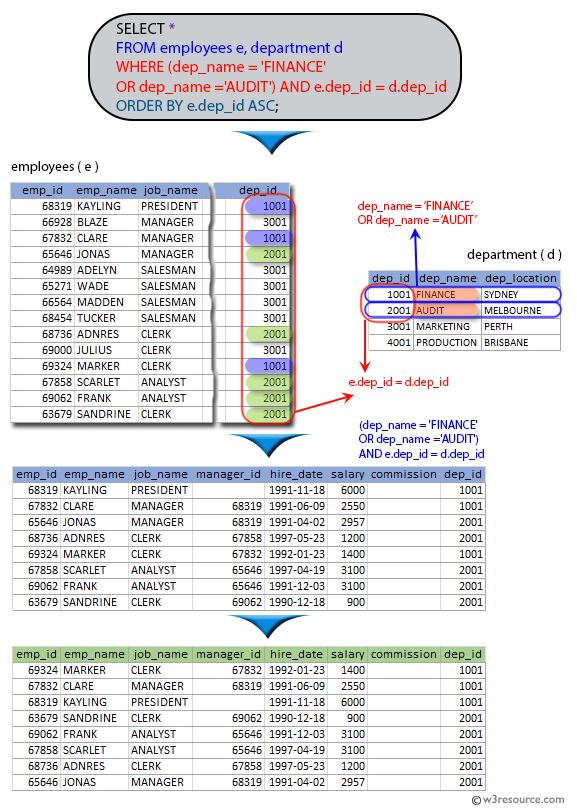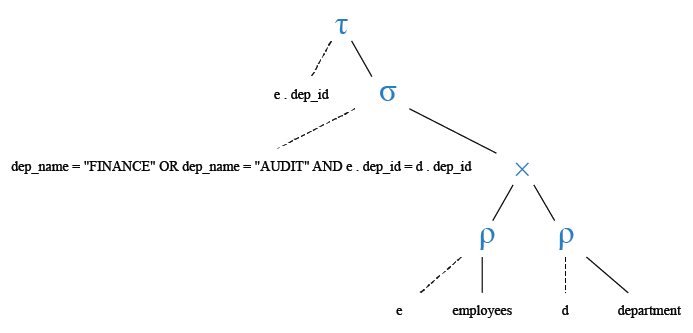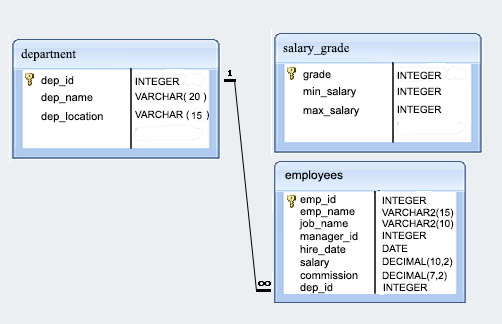SQL Exercise: Employees under a given department ORDER BY dep_id ASC
[An editor is available at the bottom of the page to write and execute the scripts.]
82. From the following table, write a SQL query to find the location of all the employees working in the FINANCE or AUDIT department. Sort the result-set in ascending order by department ID. Return complete information about the employees.
Pictorial Presentation:

Sample table: employees
Sample table: department
Sample Solution:
SELECT *
FROM employees e,
department d
WHERE (dep_name = 'FINANCE'
OR dep_name ='AUDIT')
AND e.dep_id = d.dep_id
ORDER BY e.dep_id ASC;
OR
SELECT *
FROM employees e,
department d
WHERE d.dep_name IN ('FINANCE',
'AUDIT')
AND e.dep_id = d.dep_id
ORDER BY e.dep_id ASC;
Sample Output:
emp_id | emp_name | job_name | manager_id | hire_date | salary | commission | dep_id | dep_id | dep_name | dep_location --------+----------+-----------+------------+------------+---------+------------+--------+--------+----------+-------------- 68319 | KAYLING | PRESIDENT | | 1991-11-18 | 6000.00 | | 1001 | 1001 | FINANCE | SYDNEY 67832 | CLARE | MANAGER | 68319 | 1991-06-09 | 2550.00 | | 1001 | 1001 | FINANCE | SYDNEY 69324 | MARKER | CLERK | 67832 | 1992-01-23 | 1400.00 | | 1001 | 1001 | FINANCE | SYDNEY 67858 | SCARLET | ANALYST | 65646 | 1997-04-19 | 3100.00 | | 2001 | 2001 | AUDIT | MELBOURNE 69062 | FRANK | ANALYST | 65646 | 1991-12-03 | 3100.00 | | 2001 | 2001 | AUDIT | MELBOURNE 63679 | SANDRINE | CLERK | 69062 | 1990-12-18 | 900.00 | | 2001 | 2001 | AUDIT | MELBOURNE 68736 | ADNRES | CLERK | 67858 | 1997-05-23 | 1200.00 | | 2001 | 2001 | AUDIT | MELBOURNE 65646 | JONAS | MANAGER | 68319 | 1991-04-02 | 2957.00 | | 2001 | 2001 | AUDIT | MELBOURNE (8 rows)
Explanation:
The said query in SQL that selects all columns (*) from the employees table and the department table where the department name is either 'FINANCE' or 'AUDIT', and the dep_id column in the employees table matches the dep_id column in the department table.
The WHERE clause includes only those employees who belong to the 'FINANCE' or 'AUDIT' and joins the employees and department tables on the dep_id column.
Relational Algebra Expression:

Relational Algebra Tree:

Go to:
PREV : Sort employees by designation, joining after 1991.
NEXT : List the employees along with grades in ascending order.
Practice Online
Sample Database: employee

Have another way to solve this solution? Contribute your code (and comments) through Disqus.
What is the difficulty level of this exercise?
Test your Programming skills with w3resource's quiz.
